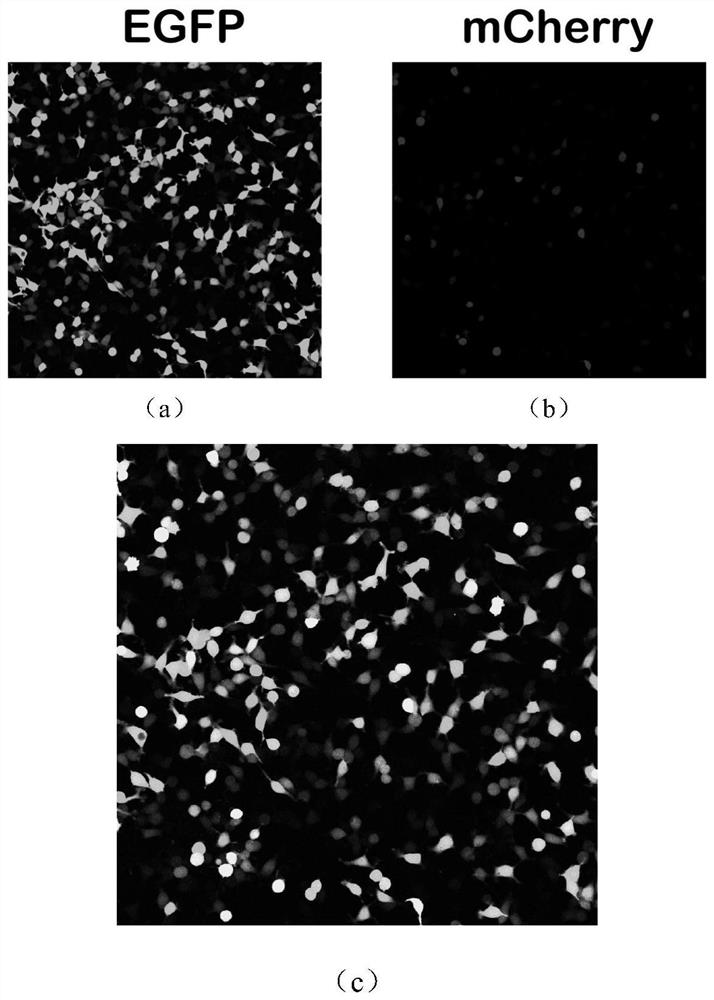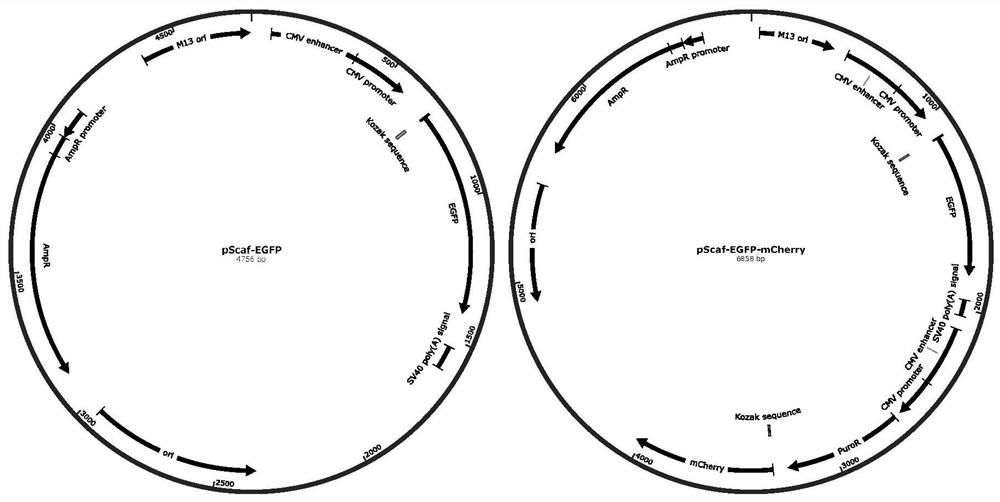Use of single-stranded DNA in gene transfection
A gene transfection, single-stranded technology, applied in DNA preparation, recombinant DNA technology, microbial assay/inspection, etc., can solve the problems of easy degradation, difficult to obtain RNA, instability and so on
- Summary
- Abstract
- Description
- Claims
- Application Information
AI Technical Summary
Problems solved by technology
Method used
Image
Examples
Embodiment 1
[0044] The EGFP cssDNA and EGFP-mCherry cssDNA produced based on the pScaf vector of this example are used for transfection of 293T cells, Hela cells, and A549 cells:
[0045] Step 1. Construction and extraction of cssDNA
[0046] (1) Insert the EGFP gene and EGFP-mCherry gene into the pScaf vector to construct the pScaf-EGFP vector and pScaf-EGFP- mCherry vector (such as image 3 shown);
[0047] (2) Co-transform 10ng pScaf-EGFP vector, 10ng pScaf-EGFP-mCherry vector and 15ng M13-based pSB4423 plasmid into XL1-Blue competent cells, plate, and culture at 30°C for 16h;
[0048] (3), pick a single clone in 1mL 2×YT (5mM MgCl 2 ) culture medium at 30°C, 220rpm for 1h;
[0049] (4), the above medium in 5mL 2 × YT (5mM MgCl 2 , 100 μg / mL ampicillin sodium, 20 μg / mL chloramphenicol) for 4 hours, 30 ° C, 220 rpm;
[0050](5) Cultivate the above bacterial liquid in 200mL 2×YT medium at 30°C and 220rpm, wherein pScaf-EGFP is cultivated for 8h, and pScaf-EGFP-mCherry is cultivated...
Embodiment 2
[0073] The linear single-stranded DNA produced based on asymmetric PCR in this example: EGFP lssDNA is used for transfection of 293T cells and MGC803 cells:
[0074] Step 1. Construction and extraction of lssDNA
[0075] (a), prepare the PCR reaction system according to the following formula:
[0076] Reverse product amplification: pEGFP-N1 plasmid: 2 μL (10ng / μL), upstream primer: 2 μL (0.2 μM), downstream primer: 2 μL (10 μM), PrimeSTAR Max Premix (25 μL, R045A, Takara); ddH 2 O: 19 μL.
[0077] Forward product amplification: pEGFP-N1 plasmid: 2 μL (10ng / μL), upstream primer: 2 μL (10 μM), downstream primer: 2 μL (0.2 μM), PrimeSTAR Max Premix (25 μL, R045A, Takara); ddH 2 O: 19 μL.
[0078] Wherein, the upstream primer sequence in forward product amplification and reverse product amplification is shown in SEQ ID NO.3, and the downstream primer sequence is shown in SEQ ID NO.4.
[0079] (b), amplify according to the following reaction:
[0080] React at 95°C for 10 min,...
PUM
 Login to View More
Login to View More Abstract
Description
Claims
Application Information
 Login to View More
Login to View More - R&D
- Intellectual Property
- Life Sciences
- Materials
- Tech Scout
- Unparalleled Data Quality
- Higher Quality Content
- 60% Fewer Hallucinations
Browse by: Latest US Patents, China's latest patents, Technical Efficacy Thesaurus, Application Domain, Technology Topic, Popular Technical Reports.
© 2025 PatSnap. All rights reserved.Legal|Privacy policy|Modern Slavery Act Transparency Statement|Sitemap|About US| Contact US: help@patsnap.com



